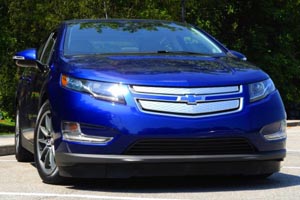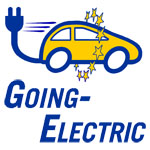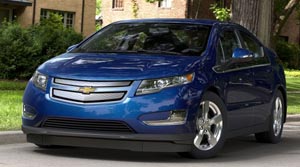Going Electric !
Our 16 year-old Rav4 had 220,000 miles, and was still running strong, but the clutch was finally showing signs of wear so we decided to look into a new car.
We wanted to go electric, so we surveyed the current state of the technology, keeping in mind we only have one car and so it had to cover all of our needs.
You basically have three choices of electric vehicles today, Hybrid, Plug in Electric only, and Extended Range Electric.
Hybrid Electric Vehicles (like the Prius):
These are basically gas vehicles using an electric motor to improve the miles per gallons. Although a move in the right direction, you can get clean diesel vehicles (like the Volkswagens) that are more fun to drive and that have as good or better miles per gallon than the best hybrids, so for me today it is only a partial solution.
Plugin Electric only Vehicles (like the Nissan Leaf or coming Fiat 500e and Chevy Spark EV):
If you are going electric, this is the real deal as you are 100% electric. The main issues here are the range and the time to charge. The first models like the Leaf had a little over 75 miles of range and would take a minimum of 8 hours to recharge on a fast charger.
Both of these issues are improving. With the latest models like the 500e or the Spark, range is getting close to 90 miles per charge, and for the Spark, a fast charging option can recharge 80% of the battery in 20mn.
But even with these improvements, if this is your only car, you end up severely limited when you need to take a long trip. Charging stations (especially the ones that could do an 80% charge in 20mn) are rare, and so you cannot easily plan to drive long distances with these cars yet, making them a hard choice as an only car.
Extended Range Electric Vehicles (like the Chevrolet Volt):
These are 100% electric vehicles, meaning that the wheels are only powered by an electric motor, but you have a small gas engine that can be used as an electric generator to provide electricity to the electric motor when the battery is depleted. The advantage of this solution, is that you (almost) get the best of both worlds.
The range of a Volt today is announced at 38 miles (although you can easily get around 40/45 miles on a charge).
As long as you are on battery power (driving less than 40 miles per day, or have a charge station at work), you are only using electricity and never need a drop of gas. But if you have to take a longer trip, you don’t have to worry about being stranded or having to find a charge stations and wait for recharge. You can let the gas powered electricity generator power the electric engine in a totally seamless transition. The amazing part is that even when driving with the electric motor powered by the gas powered electric generator, you actually get about 40 miles per gallon which is better than most cars on a gas engine only.
And when running on electricity, depending how much you pay for your electricity, you can easily be in the 150 Miles Per Gallon equivalent.
So for us, having a single car, there was no question, the Volt Extended Range Vehicle was the absolute best solution.
Now given the technology is still evolving a lot, and given interest rates are at their lowest with aggressive lease incentives on these cars, we decided to take the Volt on a lease. A 3-year lease with a 3-year warranty and 3 years of OnStar included should provide a trouble free experience 
Experiencing the Volt
 [*** ERROR: Weaver X-Plus Shortcoder undefined id: 'clear-on-mobile' *** ]We have only had the car a few weeks, but we are already thrilled!
[*** ERROR: Weaver X-Plus Shortcoder undefined id: 'clear-on-mobile' *** ]We have only had the car a few weeks, but we are already thrilled!
Although we expected it somewhat, the addiction to efficiency on this car is almost comical. The number of miles per charge is updated every day based on your past driving, and so every morning you find yourself cheering the new higher number (it started at 37 miles when we got the car, but you can easily get in the 40/45 miles per charge or more, depending on driving style / terrain and weather conditions). We’re at 45 and dreaming of 50  Update: We reached 54 miles on a charge in city driving!
Update: We reached 54 miles on a charge in city driving!
All the dials in the car allow you to optimize every aspect of your energy consumption, showing you, among other things, the real time flow of kilowatts from the battery to the electric motor or from the electric motor to the battery when using regenerative breaking.
An interesting option in the Volt regarding regenerative breaking is the L mode. When using L (which we now do all the time), regenerative breaking is applied as soon as you lift your foot from the gas pedal and is proportional to how much you lift it. This not only maximizes the recharging of the battery while you drive, but it allows you to regulate your speed very comfortably with a minimum of back and forth between the accelerator and the brake pedal.
Not going to the gas station any more is another great source of satisfaction of course 
Another thing that surprised me is how much pickup speed you get if you need it. If you floor the gas pedal, you get the full torque of the electric engine and it is quite strong. You also have a sport mode at the touch of a button to get this responsiveness all the time (at the expense of your electricity consumption, of course).
The technology in the Volt is actually pretty amazing: the electric engine is used to move the car and to recharge the battery; the electricity generator can be powered by the gas engine to recharge the battery or directly power the electric motor; and the generator can even assist the electric motor when driving at high speed (providing a second electric motor to power the car). But the driving experience is the same regardless of what is going on. All these transitions are totally seamless.
In the end you can forget about the technology, and simply enjoy the (silent) drive. The car is comfortable, lively, handles very well, and I find it pleasing to the eye.
Over the next few years, I am sure technology will give us more range and a faster charge, but even at this stage, I find the Chevy Volt to be an amazing car.
If you have never thought of it, I highly recommend taking one for a test drive and playing with the sport mode
To hear from Volt Owners go to this independent GM-Volt forum.
Nicola’s Elf
Statistics of our first 1360 miles :
1170 Miles using 243 kWh for $32 of electricity
Comes up to 166 MPGe
Gas generated electricity Mode:
192 Miles using 5 Gallons for $22 of Gas
Comes up to 39 MPG
Gas + Electric:
1360 Miles for $54
Comes up to 113 All MPGe






Come visit us on gm-volt.com, would love to see you participation. We are proud owners of 2 Chevy Volts!
Already on, great site ! (See the link at the bottom of the post :) )
Nicola
Great write-up. Thanks for helping get the word out!
Thanks
This car deserves every bit of promotion :)
Your post implies that you don’t realize the Volt can be powered by the gas engine or the electric motor or both.
Yes, both.
GM was unclear on this during the early days of the Volt, but in late 2011 admitted this car is a plug-in hybrid, NOT an extended-range EV.
Actually if you read carefully, I did mention that: “and the gas powered electricity generator can even assist the electric motor when driving at high speed”
That being said, the gas engine never powers the car directly and solely, it powers the generator which can be coupled to help the Electric motor, this only happens at high speeds AND if you are using the gas engine (battery depleted or chose the conservation mode)
Overall, the Volt drivetrain is very different from the hybrid system, and in my mind deserves to be called an extended range EV and not a hybrid (not that I really care about labels :) ). So far this mode has never kicked in on our Volt, even at 70mph on the highway, so it is a very rare occurrence and only accounts for a minuscule percentage of the Volt use.
Now I did not want to get too technical about the whole thing as it is fairly elaborate, but you can see the complete explanation of the Volt amazing drivetrain here.
http://www.youtube.com/watch?v=AX5ZwzNwTc4
Actually after discussion with some other volt owners and re watching the video the following clarification is in order.
As long as battery power is available, the Gas engine will NEVER be used. At high speed (above 70mph), the car will get additional power by combining the main Electric engine and the Generator, but powering the generator with the battery.
Basically the Volt has TWO electric motors, the main one and a generator. But the generator can either be powered by the gas engine to produce electricity, or powered by the battery to be used as a second electric motor.
And so it is only when the battery is depleted and you are already using the gas engine to power the generator that the gas engine is eventually contributing to power the car above 70mph.
A noteworthy difference :)
//green.autoblog.com/2010/10/11/gm-yes-the-volts-gas-engine-can-power-the-wheels/
GM seems to contradict that notion.
It actually confirms what I just explained :)
Read carefully “when going above 70 mph in charge sustaining mode, and the generator gets coupled to the drivetrain, the gas engine participates in the motive force. ”
“Charge sustaining” mode” is a mode in the volt where the owner can force the gas engine to run in order to preserve the battery for later use.
So As I explained before, if the gas engine is already running (because your battery is depleted, or because you have forced it to run to preserve the battery), then above 70mph when the generator is made to help the electric motor, you will effectively have the gas engine powering the generator itself powering the wheel, and yes at that point the gas engine is helping powering the wheel.
EDIT: The coupling of the generator can occur at any speed above 36mph if it can improve efficiency (like stable speeds). So when Using the gas engine (an only then) the engine may end up coupled to the electric motor for maximum efficiency
But as long as you have battery and you don’t manually force the engine to run, the car can operate at any speed ONLY using electricity. Using the gas engine is optional.
That article is way out of date now.
It really looks like some PR flack at GM put out the press release before they had any understanding of what the Genus Engineers had given them. I can just see the press reports seeping into the lab and the GE’s going “What?! We never said that!” and then having a discussion with said flack about how it really worked. And like “Telephone” flack heard something entirely different from what was said, and the process repeating…
The Video does not actually say it needs to be 70 MPH, it is just an example. Now we know that Two-Motor Mode occurs at steady speeds as low as 38 MPH, all the way to top speed. The reason for running the two motors together is not as you say, to increase power, but rather to increase efficiency. Running a gas motor at high RPM’s is usually less efficient than a more moderate speed, and electric motors are no different. By using the second motor to spin the ring gear it, in effect, adds an “overdrive” and reduces the main motor RPM down into it’s “sweet spot”. Try this: Cruise on the highway at some constant speed, say 60 for a few minutes. After running steady state for a while mash the pedal down as if to pass. You will feel a little hesitation before full power is applied (If you have been cruising long enough). This hesitation is the Volt transmission spinning the generator down to zero RPM and locking the ring gear to the case so that the main motor can give you the power you requested. If you let up and mash the pedal down again, the power will come on right away, as there is a delay before the Two Motor Mode engages again. Once the battery is depleted the gas engine contributes it’s torque to spin the generator, and in Two Motor Mode also spin the ring gear. There may be a little more hesitation when mashing the pedal since the gas engine has to disconnect from the generator in order to bring the generator to zero RPM, I don’t really know since I rarely use the gas engine at all. (14.8 gallons since 6-8-11.) P.S. I’ve found it’s best to ignore AA-Ron.
I am a delighted owner of a 2013 Volt and I really can’t understand why it is that – for some people – there is a fanatical preoccupation with the .0001% conceptual chance that under some rare and precise circumstances the Volt can possibly “couple” to perhaps get up to 10% of its power from the engine. Compared to the litany of stories about serious, real-world EV problems… Nissan Leaf batteries losing up to 40% of their capacity in 3 years, Prius hybrids failing emissions tests… THESE are the kinds of issues that the EV public should be focused on! Why for the love of God don’t they get angry about something that matters instead of focusing on something that is mostly theoretical and unimportant.
I have driven my Volt for 5 months and have had nothing but pure joy throughout my 90% gasoline-free driving. I have taken two highway trips in “hold” mode, where I deliberately directed the car to use only the engine. One trip was 5 hours and the other 6 hours. I was thrilled with the fuel economy and astonished at how seamless and imperceptible the transition from EV to Generator was.
On other occasions where I needed to travel outside of my normal daily commuting radius, I didn’t even think for a moment if I could “make it”. I just let the car do what it needed to do without a care in the world.
I find it to be an incredibly eco-friendly car. not just because it is so efficient with and without the use of gasoline but also because I do not need to be responsible for the production/ownership/maintenance of a second or third car to do everything that Limited Range EVs can not do.
The Volt is truly the perfect blend of EV technology and multi-purpose approach to getting the most out of a single vehicle.
I could not agree more :)
We live in a day an age where polarization of people is everywhere (widely thanks to media an political outlets). As a result people feel increasingly compelled to argue fiercely about everything outside of their belief or comfort zone when there is little to no benefit from doing so, and instead of simply engaging in meaningful productive discussion.
Some critical thinking and open mindedness teaching in school would go a long way, not mentioning actual affordability of higher education. But this is for another discussion :)
This article contains a lot of misinformation. Most 2013 EVs charge at 6KW which allows them to fully charge in 3-4 hours. It doesn’t mention the Model S, its fantastic range and supercharging capability or the tesla powered Rav4 which is a more affordable vehicle while offering decent range.
I am glad that the you enjoys the volt and uses the gasoline engine very little; as battery technology advances hopefully you wont need training wheels on your next car.
I think your use of the word misinformation is a bit exaggerated may be :)
This was not meant (and never pretended) to be an extensive study of electric vehicles, but to give people the broad strokes on electric vehicles today for normal people, keeping it simple to digest.
Yes many cars today can charge at 6kw in about 4 to 6 hours, but that does not change the core issue of charging time, charging 80% in 20mn does this is why I simply mention the base system everyone can use at no extra cost (240v chargers are not cheap) and the significant improvement in newer models coming up that truly enable to recharge on the go.
Yes the model S is a great car and it falls in the full electric category I mentioned like the RAV4. I did not pretend to provide a complete list of electric cars, I only gave a few of the most common / affordable examples to illustrate each category. And with a price between 70k and 100k the model S is not for the most common people :).
Again I was going for broad stroke, keeping it simple and easy to understand, and take the opportunity to say how much we enjoy the Volt. I certainly simplified for the sake of the article, but I don’t believe I misrepresented anything :)
In Europe we have the Opel Ampera, which is technically the same and in Europe a little bit cheaper than the imported Volt.